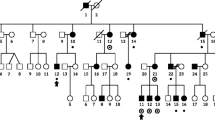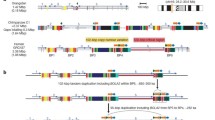Abstract
A 3.5-Mb region of the X chromosome underwent duplication and transposition to the Y chromosome ~5–6 Mya. This X-transposed-region (XTR) originated at Xq21.3 and was inserted at Yp11.2. The two locations have 98.78 % homology and a high concentration of tandem repeats. In whole-genome scans of ten large families with dyslexic members, we identified transposed blocks comprising >102 kb of the Yp11.2 region in its homologous region at Xq21.3 in three females from three different families. Although recombination is known to be limited only to the pseudoautosomal regions (PARs) of the X and Y chromosomes, we report allelic unequal recombination between the XTR region Yp11.2 and Xq21.3, indicating the presence of a new PAR, which we named PAR3. This PAR3 region was also found in 2 % of the general population. An additional layer of justification could be provided from six other dyslexic cases which harbored duplications and deletions in the same Xq21.3 and Yp11.2 regions through allelic unequal recombination.




Similar content being viewed by others
References
Affymetrix Inc. (2005) Technical note: guide to probe logarithmic intensity error (PLIER) estimation
Affymetrix Inc. (2007) White Paper: BRLMM-P: a genotype calling method for the SNP array 5.0
Affymetrix Inc. (2008) User manual: Genotyping Console™ Software 2.1
Affymetrix Inc. (2009) Data sheet: Genome Wide Human SNP Array 6.0
Benyamin B, Visscher PM, McRae A (2009) Family-based genome-wide association studies. Pharmacogenomics 10:181–190
Birdsuite (2010) http://www.broad.mit.edu/mpg/birdsuite/birdseed.html
Charlesworth B (1991) The evolution of sex chromosomes. Science 4997:1030–1033
De Bonis ML, Cerase A, Matarazzo MR, Ferraro M, Strazzullo M et al (2006) Maintenance of X- and Y-inactivation of the pseudoautosomal (PAR2) gene SPRY3 is independent from DNA methylation and associated to multiple layers of epigenetic modifications. Hum Mol Genet 15:1123–1132
DGV CNV Database (2012) http://projects.tcag.ca/cgi-bin/variation/xview
Flaquer A, Rappold GA, Wienker TF, Fischer C (2008) The human pseudoautosomal regions: a review for genetic epidemiologists. Eur J Hum Genet 16:771–779
Giouzeli M, Williams NA, Lonie LJ, DeLisi LE, Crow TJ (2004) ProtocadherinX/Y, a candidate gene-pair for schizophrenia and schizoaffective disorder: a DHPLC investigation of genomic sequences. Am J Med Genet Part B 129B:1–9
Jobling MA, Lo LC, Turner DJ, Bowden GR, Lee AC et al (2007) Structural variation on the short arm of the human Y chromosome: recurrent multigene deletions encompassing Amelogenin Y. Hum Mol Genet 16:307–316
Lambson B, Affara NA, Mitchell M, Ferguson-Smith MA (1992) Evolution of DNA sequence homologies between the sex chromosomes in primate species. Genomics 14:1032–1040
Lima RD, Iamanda CF, Silva LR, Mello MP, Maciel-Guerra AT (2008) An illustrative case of Leri–Weill dyschondrosteosis. Genet Mol Biol 31:839–842
Lopes AM, Ross N, Close J, Dagnall A, Amorim A et al (2006) Inactivation status of PCDH11X: sexual dimorphisms in gene expression levels in brain. Hum Genet 119:267–275
Mangs AH, Morris BJ (2007) The human pseudoautosomal region (PAR): origin, function and future. Curr Genomics 8:129–136
Ohno S (1967) Sex chromosomes and sex-linked genes. Springer Books, Berlin
Page DC, Harper ME, Love J, Botstein D (1984) Occurrence of a transposition from the X-chromosome long arm to the Y-chromosome short arm during human evolution. Nature 311:119–123
Rappold GA, Klink A, Weiss B, Fischer C (1994) Double crossover in the human Xp/Yp pseudoautosomal region and its bearing on interference. Hum Mol Genet 3(8):1337–1340
Ried K, Rao E, Schiebel K, Rappold GA (1998) Gene duplications as a recurrent theme in the evolution of the human pseudoautosomal region 1: isolation of the gene ASMTL. Hum Mol Gene 7:1771–1778
Ross MT, Grafham DV, Coffey AJ, Scherer S, McLay K et al (2005) The DNA sequence of the human X chromosome. Nature 434:325–337
Rozen S, Skaletsky H, Marszalek JD, Minx PJ, Cordum HS et al (2003) Abundant gene conversion between arms of palindromes in human and ape Y chromosomes. Nature 423:873–876
Skaletsky H, Kuroda-Kawaguchi T, Minx PJ, Cordum HS, Hillier L et al (2003) The male-specific region of the human Y chromosome is a mosaic of discrete sequence classes. Nature 423:825–837
SVS Golden Helix (2010) SVS Golden Helix testing manual. http://www.goldenhelix.com/SNP_Variation/tutorials/snp-with-svs7/introduction.html
Weissenbach J, Levilliers J, Petit C, Rouyer F, and Simmler M-C (1987) Normal and abnormal interchanges between the human X and Y chromosomes. Development 101(Suppl):67–74
Williams NA, Close J, Giouzeli M, Crow TJ (2006) Accelerated evolution of Protocadherin 11X/Y: a candidate gene-pair for cerebral asymmetry and language. Am J Med Genet Part B 141B:1–11
Zarate YA, Dwivedi A, Bartel FO, Corning K, DuPont BR (2011) 47, XY, +der(Y), t(X;Y) (p21.1;p11.2): a unique case of XY sex reversal. Am J Med Genet Part A 155:386–391
Acknowledgments
We thank the subjects and their families for participating in this study; Prof. H. A. Ranganath for his help and encouragement; Marita J, Anand S, and Shyamala K.V. for their help in sample collection; the services of Vimta Labs Ltd.; University of Mysore for providing facility to conduct this work; and the Department of Science and Technology—Health Science (SR/SO/HS-103/2007) for funding, Government of India, New Delhi.
Ethics statement
Written consent was obtained from all participants involved in this study and the Institutional Human Ethical Committee (IHEC no. 3/RI/2008-09) approved the consent procedure.
Author information
Authors and Affiliations
Corresponding author
Electronic supplementary material
Below is the link to the electronic supplementary material.
Supplementary Fig. 1
Illustration of three pedigrees under study. a, b and c are the pedigrees of three dyslexic families showing the recombined blocks of Yp11.2 in one of the X-chromosome Xq21.3 region (a-IV-2; b-III-11 and c-III-6). The arrows indicate the probands which shows the duplicated and deleted blocks found in Xq21.3/PCDH11X/TGIF2LX region (a-V-2 and b-III-10). (JPEG 912 kb)
Supplementary Fig. 2
(JPEG 177 kb)
Rights and permissions
About this article
Cite this article
Veerappa, A.M., Padakannaya, P. & Ramachandra, N.B. Copy number variation-based polymorphism in a new pseudoautosomal region 3 (PAR3) of a human X-chromosome-transposed region (XTR) in the Y chromosome. Funct Integr Genomics 13, 285–293 (2013). https://doi.org/10.1007/s10142-013-0323-6
Received:
Revised:
Accepted:
Published:
Issue Date:
DOI: https://doi.org/10.1007/s10142-013-0323-6




